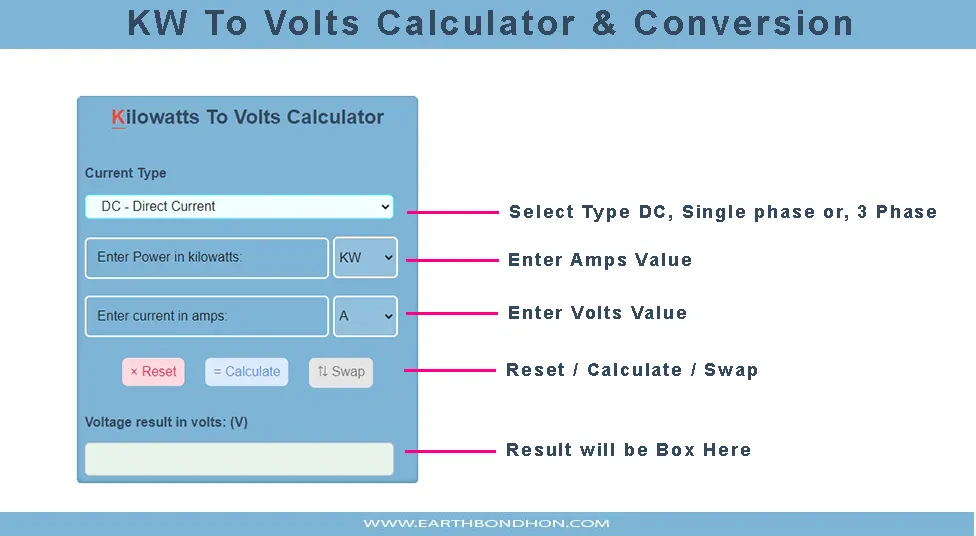KW to volts Calculation - Online Electrical Calculators
Kilowatts (KW) to Volts (V) Calculator.
Enter the Real Power (P) in kilowatts (kW), current (I) in amps (A), and press the calculate button to get the voltage in volts (V):
Advertisements
Note, For higher values like 5×103, 10×10-6, 1.6 x1012, enter the value like this for scientific notation as 5e3, 10e-6, 1.6e12, etc.
Conversion Using the Power Formula :
DC KW to Volts Calculation:
The voltage in volts (V) is equal to 1000 times the Real Power (P) in kilowatts (kW), divided by the current (I) in amps (A):

For example, If the power consumption is 10 kilowatts and the current flow is 4 amperes, the voltage is in volts.
V(V) = 1000 x 10 ÷ 4
V(V) = 2500 V
AC Single Phase KW to Volts Calculation:
The voltage in volts (V) is equal to 1000 times the Real power (P) in kilowatts (kW), divided by the power factor PF times the current (I) in amps (A):

For example, If the power consumption is 15kW with a phase current of 5A and power factor of 0.8 the voltage in volts.
V(V) = 1000 x 15 ÷ 0.8 x 5
V(V) = 3750 V
Ac Three Phase Watts to Amps Calculation :
Calculation with Line to Line Voltage:
The line-to-line RMS voltage VL-L in volts (V) is equal to 1000 times the Real power (P) in kilowatts (kW), divided by the square root of 3 times the power factor PF times the current I in amps (A):

For example, If the power consumption is 5kW and the phase current is 2A, the RMS voltage is in volts.
V(V) = 1000 x 5 ÷ √3 x 0.8 x 2
V(V) = 1804 V
Calculation with Line to Neutral Voltage:
The line to Neutral RMS voltage VN-L in volts (V) is equal to 1000 times the Real power (P) in kilowatts (kW), divided by the 3 times the power factor PF times the current (I) in amps (A):

For example, If the power consumption is 5kW and the phase current is 5A, the RMS line-to-neutral voltage is in volts.
V(V) = 1000 x 5 ÷ 3 x 0.8 x 5
V(V) = 416 V
Where:
-
- P = Power in Kilowatts (KW)
- V = Voltage in volts
- I = Current in amperes
- Cosθ = Power factor in AC circuits
- VL-L = Line to Line Voltage in 3-Phase Circuits
- VL-N = Line to Neutral Voltage in 3-Phase Circuits
Advertisements
How to use This Calculator?
To use the above “Kw to Volts Conversion Calculator” follow the below steps:
01. Select Phase Type: Choose between “DC Line” “Single Phase” or “3 Phase” by choosing the appropriate option from the dropdown.
02. Enter Real Power: Input the Real Power in KW value in the specific input box. You can enter the value in watts or kilowatts by choosing the appropriate option from the dropdown.
03. Enter Current: Input the Current in Amps value in the specified input box. You can enter the value in A or KA by choosing the appropriate option from the dropdown.

04. Reset: If you want to “reset” the calculator to perform another conversion, you can click the “Reset” button, and all input fields will be cleared.
05. Calculate: Click the “Calculate” button to obtain the results. The calculated results will be displayed in the “Results:” section.
06. Swap: If you want to “Swap” the calculated to Exchange conversion, you can click the “Swap” button, and Calculate will be Exchange.
07. Result: The calculated “result” will be displayed in the respective “Result In volts (V)” output field.
| Device | Typical PF |
|---|---|
| Resistive Load | 1 |
| Fluorescent Lamp | 0.95 |
| Incandescent Lamp | 1 |
| Induction Motor full load | 0.85 |
| Induction Motor no Load | 0.35 |
| Resistive Oven | 1 |
| Synchronous Motor | 0.9 |
| Power Factor Value conversion table | |
Frequently asked questions
KW is the abbreviation of kilowatt. In other words, it represents 1000 watts. It is the measure of power that is often converted into the form of usable output.
What is the formula for conversion from KVA to KW? Solution: The formula for the conversion of KVA to KW is as follows: KVA × pf = KW, where pf is the power factor (pf).
An ampere is the unit used to measure electric current. Current is a count of the number of electrons flowing through a circuit.
That's it! In other words, watt=amp X volt. Sometimes you will see this formula written as W=A X V. For example, if the current is 10 amps (10A) and the voltage is 220V, you multiply 10 by 220, to get 2200W (watts).
The current flowing in power lines and normal household electricity that comes from a wall outlet is alternating current.